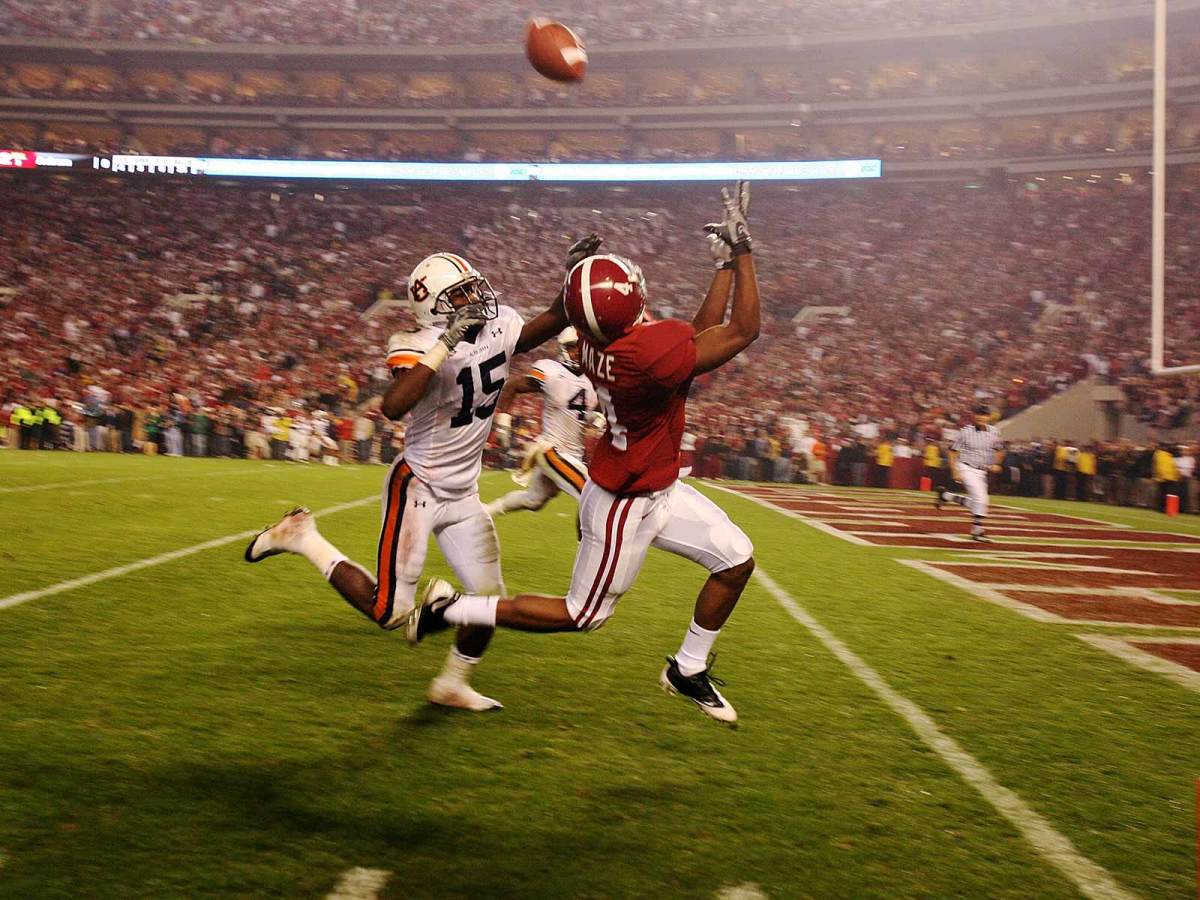Ten Years Ago, A Cathartic Blowout of Tommy Tuberville Turned the Tide in the Iron Bowl

Greg McElroy messed up. Years later, he freely admits it might be the best mistake of his life. Leading 29–0 over Auburn in the 2008 Iron Bowl, McElroy and the rest of the Crimson Tide’s reserves were milking way the clock. On a third-and-six, with three minutes left in the game, offensive coordinator Jim McElwain called a play designed for McElroy to throw to tight end Brad Smelley on a short pass that would extend the drive and basically end the game. That’s not what happened.
McElroy threw deep in a blowout, finding receiver Marquis Maze for a 34-yard touchdown to pile on the Crimson Tide’s in-state rivals. “If I would have missed the throw, Coach [Nick] Saban would have killed me,” McElroy says. “It was the icing on the cake. All those years of frustration built up in the fan base, came out.”
Bryant-Denny Stadium exploded that night in a revengeful celebration fit for a championship. That’s what it felt like on a cloudy, cool day when, finally, Alabama beat Auburn–the Tide’s first victory over the Tigers in Tuscaloosa and its first win in the series since 2001. Alabama broke its six-game Iron Bowl losing skid in dominant fashion, almost literally sending packing the man who had his thumb on Alabama for years. Auburn coach Tommy Tuberville was fired days later.
There have been far more compelling Iron Bowls, but for all the meaningful duels in this 83-year-old series, maybe this one—Alabama 36, Auburn 0—meant the most, at least to one side. “That season was the season that essentially put us back in the limelight,” McElroy says. “That game was more symbolic than anything else of ‘There’s a new sheriff in town.’” Call it a defining moment in Saban’s revival effort in Tuscaloosa. “That 2008 season was extremely special,” says John Parker Wilson, the starting quarterback on that team. “Think about where we are now. That’s where we came from.”
Saban enters this Saturday’s rendition of the Iron Bowl with, many believe, his best team ever and one of the most dominant in college football history, all of it 10 years in the making. Like 2008, the Crimson Tide are undefeated, ranked No. 1 and heading to the SEC championship game no matter the result, while Auburn is skidding to a disappointing season with a coach who, at least earlier this season, sat on a warm seat. On that night 10 years ago, Alabama not only returned to dominance in this rivalry series (it has now won seven of 10) but began an assault on college football that hasn’t been seen since Minnesota won five national championships in eight years in the 1930s.
Alabama has its eye on a sixth national championship in a 10-year span, something never before done in college football and arguably the final proof needed to assert itself as the preeminent dynasty in the sport’s 149-year-old history. Bear Bryant won six titles in a 19-season stretch, and Woody Hayes had five championships in 17 years at Ohio State. Notre Dame’s Frank Leahy won four in five years, and USC, under John McKay, claimed four over a 13-year span. Nobody has been this dominant over this period, and one of the first glimpses came on Nov. 29, 2008 in Tuscaloosa when the Tide finally beat the Tigers. “It was the first year that Alabama started the dynasty,” says Jerraud Powers, an Auburn defensive back who played in that 2008 Iron Bowl. “That year was the foundation.”

McElroy’s late touchdown pass provided the exclamation point on not only an emotional game but an undefeated regular season. This Alabama team won the old-fashioned way, unlike the one that will take the field Saturday. Running backs Glen Coffee and Mark Ingram bullied the Tigers behind a powerful offensive line led by left tackle Andre Smith, and Wilson led an efficient but conservative passing attack built around a freshman big-play receiver named Julio Jones. The defense, coordinated by 32-year-old Kirby Smart, leaned on hulking nose guard Terrence Cody, speedy linebacker Dont’a Hightower and a former walk-on turned playmaking safety, Rashad Johnson. The unit allowed just 14 points a game and entering the Auburn game had held five of its opponents to single digits.
The Tide began the season by stunning Clemson at the Georgia Dome, bashed Georgia in the famous ‘Blackout Game’ in Athens and won in overtime at LSU. Unlike his first season the year before, Saban’s team won the close games in 2008. “We just didn’t know how to win that first year,” Wilson says. They did it without a large group of veterans. The Senior Day ceremony that night was quick—there were nine on the team, the smallest senior class in the Football Bowl Subdivision in 2008. Wilson and the other eight had never beaten Alabama. “John Parker was especially fired up,” recalls Barrett Jones, an Alabama offensive lineman who redshirted that season. “As a quarterback, you’re remembered for how you play against that team. He wanted it.”
“All of us were from Alabama,” Wilson says. “If you were a player, the first question later in life is, ‘Well, what was your record against Auburn?’” To that point, it was 0–3. It had been 2,930 days since the Tide had last beaten the Tigers. “We didn’t have one player on our team that had beat Auburn,” Saban said. “That was our goal. They didn’t have a guy that lost to us.”
LITMAN: Jim Tressel and the Unintentional Guarantee That Changed Michigan-OSU
The result in the stadium? “A lot of pent-up frustration,” Jones remembers. Crimson Tide fans packed the stadium well before kickoff and stayed well after the game, their attention aimed on a man who had tormented them on the field as well as off it. During the streak, Tuberville developed a postgame ritual of flashing with his fingers the number of consecutive Auburn wins. Bama fans did not take kindly to this. During a bowl trip in 2005, four games into the streak, Tuberville was photographed in a T-shirt that heralded the streak and his ritual–a cartoon Tiger holding up four fingers and above it the words, “Fear the thumb!”
“Boy, I fired up the Bama reporters. Even nationally I got some of these reporters saying he’s classless,” Tuberville says. “When you can do anything to get the upper hand on your rival, you use it. I guess the Fear the Thumb T-shirt was the most famous. I took a lot of s--- on it.” Alabama fans came prepared that night with signage referencing Tuberville’s antics. Hugh Nall, then Auburn’s offensive line coach, remembers them well. “Here’s your thumb,” one said. “Stick it up your ass.”
“It was an angry crowd. They wanted blood after all those years,” Jones says. Jones remembers being recruited by Tuberville while in high school. Jones walked into his office one day on a visit to campus and there, sprinkled throughout the room, was memorabilia tied to the streak. “He had it everywhere.” The material found its way into the Alabama locker room before the Iron Bowl in 2007 and ’08, with photos of Tuberville holding up the fifth finger and then the sixth. “He drove Alabama people almost crazy,” says Phillip Marshall, a longtime sports reporter in the state. They’d get their revenge.
Auburn entered the game having one of the more dysfunctional offenses in the nation that season. Halfway through the season, Tuberville fired offensive coordinator Tony Franklin, scrapping his Air Raid offense for a more traditional scheme. The Tigers were terrible, but they hung around in the first half, down just 10–0 at the break. Things unraveled early in the second half, when Tuberville’s team lost fumbles on consecutive possession. Alabama scored touchdowns after both of them, and the Tide pounded the Tigers the rest of the way, finishing with 234 yards rushing. “They whipped up on us,” Nall says. “We had to fight our way out of the stadium,” Tuberville says.
DELLENGER: How Close Jimbo Fisher Came (Thrice) to Being LSU's Head Coach
“Promise you this, no Alabama fans have left!” CBS play-by-play man Verne Lundquist announced on the broadcast as a full-throated, crimson-clad 90,000 boomed their victory chant toward the Tigers. Objects were thrown at Auburn players and staff as they rushed into the tunnel toward the visiting locker room. When they emerged from the locker room an hour later, a sea of crimson greeted them. Alabama fans hadn’t left and they surrounded Auburn’s bosses. “They were taking 100 years of frustration out in one night,” Pugh remembers. Law enforcement erected barricades to keep Alabama fans from the Auburn locker room entryway. The problem: the barricades blocked players from reaching the busses. Pugh got creative. He stuck his Auburn name tag into his book bag, hopped a barricade and raced to his parents’ vehicle several blocks away. “I remember how rough we got treated after the game. Alabama fans were glad to be back,” Nall says. “It was wild. You had hoped they would have known how to act when they win one, but it had been six years.”
Tuberville and his family were whisked away in a white van bound for the airport (he flew separately from the team that night). He describes the ride out as “dicey.” Once they finally reached the team busses, Auburn players and staff sat on them for what felt like forever, with throngs of crimson surrounding the vehicles. “They wouldn’t move. They couldn’t get the streets cleared,” Powers says.
Inside and outside the Alabama locker room, it was madness. “I remember walking outside and it was like the whole city was gathered outside of our locker room,” McElroy says. “Tommy was very outspoken about how much he owned us and rightfully so. It was more fulfilling for the fans than any other victory they’ve had in their life.” That Alabama team lost the next week to No. 2 Florida and then dropped its bowl game to Utah in a stunner. The next season, most of the same players went undefeated and won the first of the program’s five national championships under Saban.
You can argue with the significance of an Iron Bowl victory over a struggling Auburn team, but Alabama, that night in 2008, reclaimed its dominance in the state and, later, the nation. And it got one of the most hated coaches in this series fired, too. “I remember seeing Tommy at the Manning Camp the following year,” says McElroy. “He said, ‘Hey, you’re the guy who got me fired.’”
